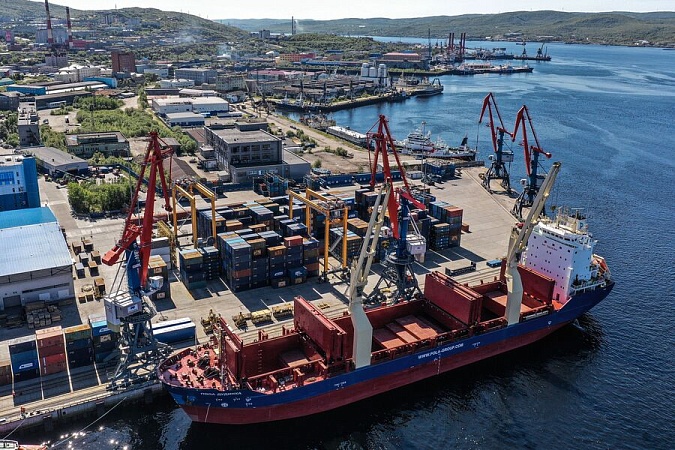On September 11, transportation process participants discussed the development of the Northern Sea Route (NSR) during the «Northern World Transport Route» session at the Annual Eastern Economic Forum. The route is eyed as a strategic route and its development will help reduce the burden on the Eastern Polygon. To that end, the Russian Arctics is now undergoing transport modernization.
According to the plans of the Government of the Russian Federation, by 2024, 80 million tons of cargo is projected to ship via the NSR every year (in 2022, the shipping total via the route was 34 million tons) and by 2030, the expectation is that shipping will top 200 million tons.
Strategic access
Construction of the Lavna port is planned for completion in 2024. At the time of the writing of this article, works are nearly complete. The port will be used as one of the junction points for the NSR. A coal terminal will be stationed on its territory as well. According to Sergey Ivanov, special representative of the President of the Russian Federation on nature protection endeavors, ecology, and transport issues, the Murmansk port is «wonderful, not matter how you look at it».
«There’s no dredging that has to be done, it doesn’t freeze over, unlike the Gulf of Finland ports, and, most importantly, it provides free access to the Worldwide Ocean,» he noted.
The State Transport Licensing Company (STLC) is tasked with the project’s implementation. A railroad is also being laid to provide transport to the Lavana port, the construction of which is being handled by holding company Russian Railways, OJSC. An important part of that is the Vykhodnoy-Lavana line being built. The feeder will become a part of the Murmansk Transport Hub (MTH), as the government of the Russian Federation allocated 37.7 billion roubles for its development last year. The MTH project will be integrated into the North-South international transport corridor and its end goal is to comprise a year-round, deepwater sea hub.
«Operational transport via the MTH to Lavna port is planned to be launched as soon as December 2023,» president and chairman of Russian Railways, OJSC, Oleg Beloziorov stated. Within the bounds of this construction, a total of 49.7 kilometers of electrified railroad and 137 artificial structures will be built. The largest-scale structure among them will be a 1.3-kilometer-long bridge across the Tuloma River.
«In 2024, a stage-by-stage enlargement of transshipment volumes will begin,» Yevgeny Ditrikh, STLC’s president, declared. He mentioned that by 2025, the Lavna port will top 18 million tons and 33-34 million tons of transshipment by the year 2030. The STLC is currently working on diversifying its cargo base, for instance considering the reloading of mineral fertilizers, which will pave the way for another 8-10 million tons to be able to be reloaded.
A helping hand from the sky
Drones may also play an important role in NSR operations. Their assistance may come in handy in composing up-to-date area maps, geodesy, carrying out infrastructure projects, as well as tracking the ice environment for the purposes of creating optimal routes and cargo deliveries.
BAS operator (the joint enterprise of STLC company and National Technological Initiatives) has the means to provide such services. Today, the company has 25 drones already and by the end of the year, the figure will rise to 180. By 2027, they expect to have 400.
Chinese interest
«Container shipments via the NSR will provide an additional opportunity to boost shipment volumes from China across the territory of Russia. However, not all cargo can be shipped via the NSR year-round in universal containers,» special representative Vladimir Panov for Article development affairs at Rosatom corporation said.
Furthermore, mineral fertilizer, food products, medications, cosmetics, and household cleaning products require a certain temperature range to be maintained. Oils and internal combustion engine additives do as well at any month besides the Winter and polyethylene products require a certain temperature range in the Summer and Fall.
«In July Chinese shipping company NewNew Shipping Line commemorated its first its new cargo container delivery service shipment from Saint Petersburg via the Northern Sea Route. The company’s performance lived up to expectations,» company representative Ke Tzin said in summing up the results of the new service’s operation after its first two months. NewNew Shipping Line plans to supply four more container ships by the end of 2023 and another 8-10 new vessels next year. The company will mainly be shipping cargos of Russian producers, in particular the lumber factory products of enterprises in the Russian Federation’s Northwestern region, which do not require a special temperature range to be maintained.
«NewNew Shipping Line’s biggest draw is the speed of its shipments. For example, shipments can be made via the Kaliningrad-Saint Petersburg-Qindao-Tianjin-Shanghai route and back via the Northern Sea Route one month faster than shipments between the Russian Federation and the PRC via the Suez Canal,» the Chinese company representative stated.



